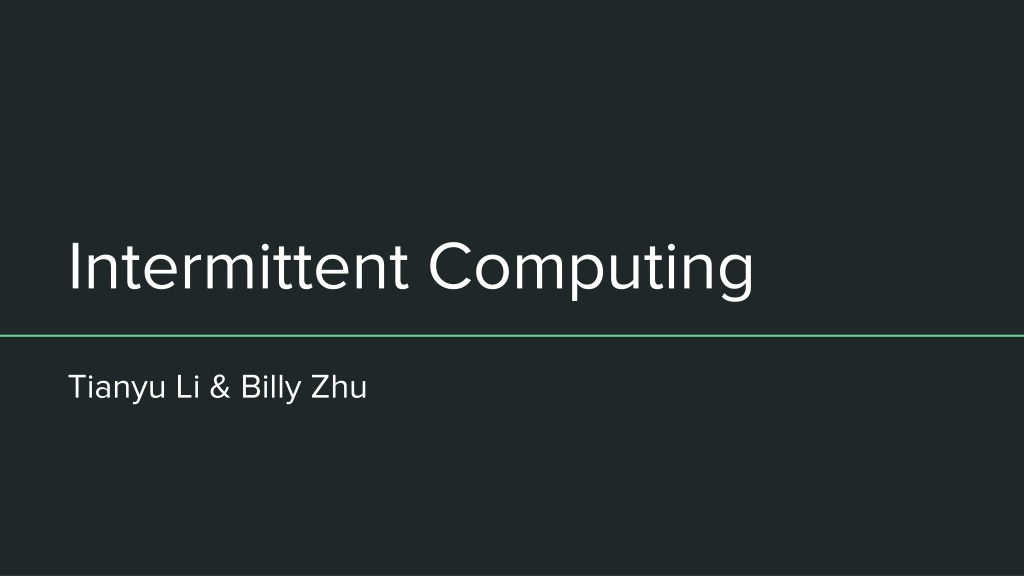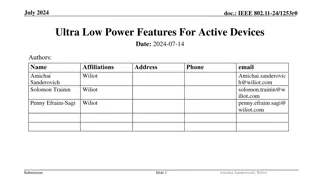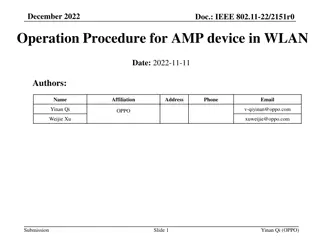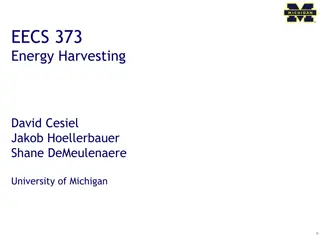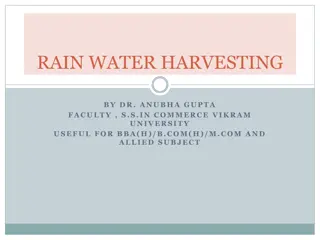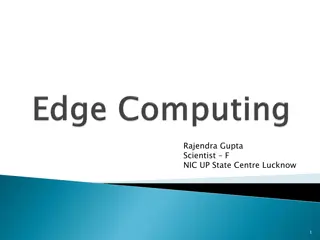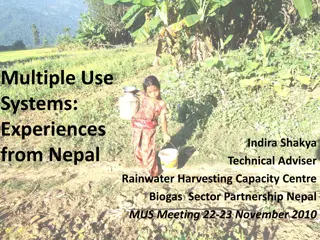Intermittent Computing: A Look into Energy-Harvesting Devices and Key Challenges
Intermittent computing, exemplified by energy-harvesting devices like the WISP RF-powered platform, poses challenges such as unreliable power leading to computation stoppages. Common techniques like checkpointing and task-based computation are employed to ensure progress and correctness in this context. Prior work has involved specialized hardware and manual programmer intervention. Today's papers discuss innovative solutions like Ratchet and Alpaca to address these challenges.
Download Presentation

Please find below an Image/Link to download the presentation.
The content on the website is provided AS IS for your information and personal use only. It may not be sold, licensed, or shared on other websites without obtaining consent from the author. Download presentation by click this link. If you encounter any issues during the download, it is possible that the publisher has removed the file from their server.
E N D
Presentation Transcript
Intermittent Computing Tianyu Li & Billy Zhu
Background Where did intermittent computing come from?
Energy-harvesting Devices - - Battery-less Operate entirely on energy extracted from the environment (sunlight, radio waves, etc.) WISP RF-powered Energy-harvesting Platform
Energy-harvesting Devices Charge: 1 s Run: 10 ms Unreliable power: Computation may stop at any time Images: 1. Joel Van Der Woude and Matthew Hicks. 2016. Intermittent computation without hardware support or programmer intervention. In Proceedings of the 12th USENIX conference on Operating Systems Design and Implementation (OSDI'16). USENIX Association, Berkeley, CA, USA, 17-32.
Key Challenges Fail-restart is the common case - - Ensure Progress Ensure Correctness
Common Techniques Checkpointing Task-based - - - General checkpoints interleaved in code State is saved before power off State is restored at power on - - - Computation divided into separate tasks Task internal state is thrown away at power off Task restarted from scratch at power on
Prior Work - Specialized Hardware - Single Checkpointing: Measure voltage and save once - Easy - Large guard bands - Wastes energy Programmer Expertise - Humans divide up the program manually - Risks never completing - Small requirement change could cause large code structure change -
Todays Papers - Ratchet (OSDI 16 Van Der Woude, Hicks) - Compiler inserts checkpoints - Identifies idempotent sections Alpaca (OOPSLA 17 Maeng, Colin, Lucia) - Task-based - Supports mixed-volatility memory Chinchilla (OSDI 18 Maeng, Lucia) - Compiler inserts checkpoints - Dynamically disables checkpoints for performance - - Images: 1. Original OSDI 16 Talk Slides 2. By Notnoisy - Own work, CC BY 3.0, https://commons.wikimedia.org/w/index.php?curid=5194892 3. By Kjersti Holmang - Own work, CC BY-SA 3.0, https://commons.wikimedia.org/w/index.php?curid=13289340
Intermittent Computation without Hardware Support or Programmer Intervention (Ratchet) Joel Van Der Woude, Matthew Hicks
Automatically Inserting Checkpoints - - Prior work: need specialized hardware / programmers Ratchet: eliminates this need - Compiler automatically adds checkpoints to code between idempotent sections
Non-volatile Memory - - Data not lost after power off Problem solved? Just save all registers periodically.
Cannot add checkpoints anywhere Write-After-Read (WAR)
Idempotent Sections Can be re-executed to get the same result Write-After-Read (WAR) Ratchet inserts a checkpoint between the write and the read
Implicitly Idempotency Violations - POP: read and update stack pointer (invalidates memory) - Replace with loads, checkpoint, and update stack pointer Reusing stack locations - Disallow sharing (-no-stack-slot-sharing) -
Timer-induced Checkpoints Ensure Progress - - - - Timer interrupts Checkpoint if failed to make progress twice Saves all registers (Needs to be set by experts)
Recovery - - - - Check if valid checkpoint exists in main Restore saved registers (only live ones were saved) Restore program counter Restart execution
Evaluation - Runtime Overhead FE: Function entry optimization, RD: Remove redundancy, LR: Live registers only
Evaluation - Cycles per Idempotent Section Shorter idempotent sections Higher runtime overhead
Evaluation - Code Size Increase - - - Recovery code Checkpoint calls Replacing POPs
Alpaca: Intermittent Execution without Checkpoints Kiwan Maeng, Alexei Colin, Brandon Lucia
Criticism of Previous Paper Only works on devices with only non-volatile memory - Many off-the-shelf microcontrollers have hybrid memory - Costs more energy and time than volatile memory Limited by static analysis
Static Task Model - - - - - No checkpoints Task manipulates privatized copies of data Commits modifications atomically upon completion Power failure - private data discarded with no cost (Similar to transactional memory with redo-logging)
Task-Based Programming Programmer decomposes program into tasks Explicitly transfers control between tasks Task-shared Variables: global scope, non-volatile Task-local Variables: private scope, initialized by task, volatile Guarantee: Task atomicity
Privatization - Scalars Variable copied to private buffer (in NVM) Subsequent accesses redirected Optimization: only privatize those involved in WAR dependencies
Two-phase Commit Pre-commit - Entry added to commit_list table (non-volatile) - Set commit_ready flag Commit - Go through commit_list and copy to original location
Arrays Same size array is privately buffered, but privatized by element - - - Initialize a copy Redirect accesses Add to commit_list via pre_commit (only for first write) First write is kept using a version-backed bitmask Limitation: Programmer must refer to array elements directly
Evaluation - Performance Normalized to (a) Plain C, (b) Alpaca
Evaluation - NVM Usage Low non-volatile memory usage important to ubiquitous computing Applicable to more kinds of devices
Evaluation - Programmer Effort Measure: Lines of code and number of keywords Complexity is between Chain and DINO
Adaptive Dynamic Checkpointing for Safe Intermittent Computing (Chinchilla) Kiwan Maeng, Brandon Lucia
Criticism of Prior Work Hard to guarantee forward-progress / termination - Explicit Task Model (e.g. Alpaca) - Require careful programming for non-termination - Hard to estimate energy use for various task input Automatic Checkpointing (e.g. Ratchet) - Blindly insert without considering non-termination - No programmer control over duration / energy-consumption of a task/section (cannot be fixed) -
Adaptive Dynamic Checkpointing Conservatively insert checkpoints to avoid non-termination Dynamically disable checkpoints to minimize overhead
Short, Predictable Blocks Criteria - - - - Statically defined Frequent enough Easy to measure energy cost Low energy variance Basic Blocks User-defined atomic blocks (atomic keyword)
Non-termination Check Measure energy consumption of each block Exhaustive, randomized, or representative inputs CleanCut energy-measuring compiler - block measurement tool
Checkpointing & Undo Logging Save only the registers and part of the non-volatile data Uses a volatile stack, with promoted variables in NVM - If live range of var begins after a checkpoint, no need to save Writes to NVM instrumented with undo logging A small non-volatile stack persists stack data not visible to compiler passes (e.g. return addr, spilled registers).
Selective Checkpointing Checkpoints skipped until timer elapsed Timer interval set at runtime by binary search Programmer only defines when to update
Evaluation - Run Time Average 2.25x speedup over Ratchet Average 2% speedup over Alpaca (human optimized)
Evaluation -Varying Capacitor Size Efficient across wide range of energy configs
Evaluation - # Checkpoints Taken Clear advantage of selective checkpointing
